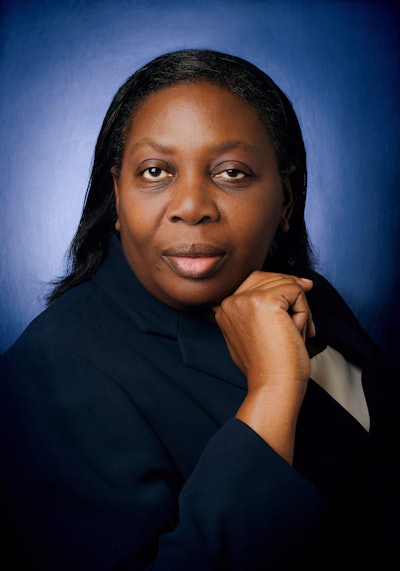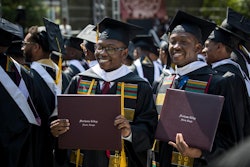As an immigrant student attending an American institution in the 1980s, Dr. Dorceta E. Taylor — a professor of environmental justice at the University of Michigan School for Environment and Sustainability — noticed something she had not expected.
 Dr. Dorceta E. Taylor
Dr. Dorceta E. TaylorIn Jamaica, where she was from, every student in her science classes was either Black or Brown, but in the U.S., when she started taking environmental courses in college, she was often the only student of color.
She says she made the mistake of asking a professor, “Where are the other Black students?” His response stunned her. She recalls his words: “Blacks are not interested in the environment.”
“This was probably one of the more shocking things I heard in my life,” she says. “I grew up with an understanding of the environment in everyone around me. They cared for the environment and understood it.”
She thought the man was a “colossal idiot” and marched to the library to figure out the truth. What she discovered there dismayed her even more.
“All the research articles said exactly what he said to me,” she says. “Blacks are not interested. They have no knowledge of the environment. They don’t care about it.”
This experience had a profound impact on her. Growing up on the Caribbean island, Taylor loved nature — waterfalls, flowers and fruits — and, very early on, biology had become her favorite subject. When she moved to the United States, she continued to study biology and the environment, but because of this incident, she became interested in social issues. Instead of immersing herself in traditional biology classes, she began to seek out other kinds of courses and programs that would give her a more formal grounding in social dynamics.
She wound up getting two doctorates at Yale University, one from the School of Forestry & Environmental Studies and the other from the Department of Sociology. Today, she is one of the preeminent environmental justice scholars in the nation. Her research interests are varied, ranging from food access to environmental justice.
In 2014, she wrote a national report analyzing racial and gender diversity in environmental organizations, which made news because she found that people of color occupy less than 16 percent of the staff in environmental organizations. This report had an impact on the environmental field. Organizations like the Nature Conservancy and Ford Foundation as well as government agencies have since committed to increasing diversity.
Taylor provides further context for these 2014 numbers. She says the first research that looked at the demographics of environmental organizations in the early 1990s, during the dawn of the environmental justice movement, showed far worse numbers.
“Even when you’re looking at the biggest organizations with the biggest staff, you’re not seeing more than about 2 percent of people of color,” says Taylor.
By the late 1990s, the environmental justice movement took off, and activists started calling attention to the low numbers. As a result, the numbers began to improve. “About nine studies done in the mid-’90s were showing 9 to 10 percent” people of color at environmental organizations, Taylor says. By 2014, the numbers climbed to 16 percent.
While the good news was that there was an increase, the bad news was that the percentage of people of color has also increased dramatically in the country. People of color comprise around 36 to 38 percent of the population, says Taylor, but since they occupy about 16 percent of the staffing in environmental organizations, they are still underrepresented.
In fact, Taylor points out that people of color occupy a higher percentage of the STEM workforce — around 20 to 25 percent.
“The even worse news is,” Taylor says, “[people of color] are occupying the entry-level and lower level positions” in environmental organizations, and there are very few hires of people of color at leadership levels.
Climate Change Education
The world is transforming due to climate change. The writing on the wall became especially clear this past summer. September 2017 was the most energetic month for hurricanes in the Atlantic in all of recorded history, battering cities and towns in the U.S. and the Caribbean. By the beginning of September, a third of Bangladesh was under water due to severe flooding, which affected 8.5 million people. A new study projects that New York City will have to deal with catastrophic 7.5-foot floods, such as the one caused by Superstorm Sandy, once every five years by the year 2030. Cities like Baltimore, Los Angeles, London and Shanghai have begun to take steps to address rising sea levels.
Higher education institutions play an important role in training students for future careers that address the needs of what is sure to be a rapidly changing world. Architects, civil engineers, city planners, insurance analysts, and the entire renewable sector must adapt and acquire new skills. Not surprisingly, universities and colleges are incorporating climate change, environmental studies and sustainability learning into their curricula.
For example, Dickinson College, a liberal arts college in Pennsylvania, is a bellwether in this regard. It has been integrating sustainability across its entire college curriculum, spanning the arts and humanities, social sciences and physical sciences.
Dickinson’s provost, Dr. Neil Weissman, chose the strategy of unifying faculty behind the academic approach to sustainability learning, says Lindsey Lyons, assistant director of the Center for Sustainability Education at the college. In 2005, a group of almost 26 different faculty members wrote the initial grant to the Mellon Foundation, which helped establish the Center for Sustainability Education.
“We have chosen not to have a major or a minor in sustainability,” says Lyons. “Instead, we’ve chosen to make sustainability a part of everyone’s learning, across the curriculum.”
Since 2008, Dickinson’s faculty have been participating in the annual Sustainability Across the Curriculum workshop every May, which guides them through the process of creating new courses on sustainability learning or modifying existing courses. Over time, 85 faculty members have attended these workshops, which has resulted in a number of course modifications. These sustainability courses are officially designated with sustainability tags through the registrar system and students and advisers can easily search for them, and the college can keep track of the sustainability courses each student enrolls in over time.
Lyons says that over 94 percent graduating students took sustainability courses in 2016-17, even when this was not a requirement, so the faculty decided to make this a general education requirement. “Every student, as part of their liberal arts general education requirement at Dickinson, now has to take at least one of these courses,” Lyons says. Data show that some students are taking 25 or 30.
The college has also been a hub for climate change education training for other institutions. In 2009, Dickinson received a $486,000 grant from NASA, which enabled the college to hold summer institutes in the summer of 2011 and 2012. The impact reached well beyond Dickinson. Lyons says 178 educators from 60 colleges and universities, representing more than 20 academic disciplines, participated in the professional development activities of the project.
After that initiative wrapped up, other initiatives have been introduced. Dickinson hosted state-level climate change education workshops in 2014 and 2015. And in 2017, for the first time, Dickinson decided to open up the Sustainability Across the Curriculum workshop to faculty from other institutions. Lyons says that, out of the 17 participants this year, nine were from Dickinson and eight were from other schools.
Dickinson is now one of 13 regional centers for Association for the Advancement of Sustainability in Higher Education, or AASHE, and Lyons says the college is committed to collaborating with faculty from other institutions.
Engaging Minority Students
While higher education institutions across the board are adapting to the needs created by climate change in different ways, historically Black i
 Andrea Orozco and Philip Bellamy, students at Bethune-Cookman University, doing fieldwork in coastal resilience.
Andrea Orozco and Philip Bellamy, students at Bethune-Cookman University, doing fieldwork in coastal resilience.nstitutions and other minority serving institutions may have to play catch-up.
Dr. J. Cho is a professor of integrated environmental science at Bethune-Cookman University, a historically Black university in Florida. Her work focuses on scientific evaluation and restoration of coastal habitats and vegetation and the use of satellite imagery to study coastal environment. She got her first teaching and research job at another HBCU, Jackson State University. She says environmental science programs are still something of a rarity in HBCUs.
While HBCUs like Bethune-Cookman and Jackson State do offer environmental science programs, Cho says, quite often, students are more interested in courses related to public health or medicine.
“It’s not because they don’t care,” Cho explains, adding that often they simply have not come across programs that would introduce them to the environmental science.
“They are very excited when they start going out in the field, and then they actually [get] hands-on experiences … going into the water, doing actual surveys,” Cho says. “They see the impact of their work and how to be the advocate to their own peers. They are grateful when they go to conferences. Oftentimes, they are the only Black people. They understand the importance of this. When they come back to the university, they like to engage more people, more students into this type of research.”
Cho and seven of her graduate students are doing important work, studying coastal resilience and place-based conservation.
Florida used to have wetlands next to estuarine water bodies, Cho explains, but Floridians constructed canals, ditches and retention ponds to prevent floods. The canals feed water directly into the estuary. This construction has altered the landscape and the natural water cycle, and land pollutants have been introduced into the natural water.
Cho and her students are changing some of these manmade shores by re-introducing native plants. The graduate students have been collecting data comparing native plant sites with turf grass neighborhoods to see which one is more effective in filtering pollutants coming from the surface runoff. Some of her students are also working on seagrass restoration, since seagrass growth has suffered due to water turbidity and changes in weather patterns. A few students are also involved in public education, Cho says, helping residents see how their actions, such as the type of fertilizer they use, may contribute to some of Florida’s ecological challenges.
Four of the graduate students doing work under Cho are supported by a federal program affiliated with the National Oceanic and Atmospheric Administration. The NOAA Center for Coastal and Marine Ecosystems, or CCME, was established in 2016 as a cooperative science center. The goal of the center is to recruit, train and graduate minority students in NOAA-mission fields and address issues confronting marine and coastal communities. It is a consortium of six minority-serving universities, led by Florida Agricultural and Mechanical University. The five other partner schools are Bethune-Cookman University; Jackson State University; California State University, Monterey Bay; Texas A&M University–Corpus Christi; and the University of Texas Rio Grande Valley. Cho is the lead investigator representing her university at this consortium.
NOAA CCME pays for the tuition, stipends, research supply and travel costs of the four CCME students working under Cho. Each of the CCME students is required to participate in a 12-week internship at a NOAA facility, which will also help them land jobs at NOAA labs and offices after they graduate, says Cho. This type of institutional support has helped strengthen the environmental science program within the larger institution.
“It helps a lot,” Cho says, about the partnership with NOAA CCME. “It has more of an influence throughout the campus.”
Wider Inclusivity
It is not a secret that students of color do not throng to environmental programs at majority institutions — for a variety of reasons.
“When you ask programs why aren’t there more students of color, they pretend to want to say those students are not interested,” Dr. Taylor, the environmental justice professor at the University of Michigan, points out. “So they fall back on what I consider to be pure stereotype.”
She runs two diversity programs at the University of Michigan — the Doris Duke Conservation Scholars Program for undergraduates and the Environmental Fellows Program for graduate students — and she says she sees evidence of demand for opportunities among people of color.
The problem lies elsewhere, Taylor suggests. Programs are not recruiting well.
“They simply have a website,” she says. “They don’t realize that, especially when you’re recruiting students of color, you need to have a personal presence also.”
Taylor goes over the game plan schools ought to adopt to recruit better. Potential students should be able to ask questions and make personal contact. They should be able to navigate the expensive tuition costs easily. Funding should be fully in place, which can help attract lower-income students.
“Once students do think of a school, what is the social and political and cultural climate in the programs?” Taylor asks. “Many of the programs are very Euro-centric in their approach, in the makeup of their faculty.” Diversification of faculty and staff and including non-European perspectives within the curriculum are additional solutions.
The entire problem stems from the fact that institutions do not expect to change very much, Taylor says. Their attitude is, “You come and fit in,” when what is necessary is bi-directional change, where the institution changes as well.
Taylor’s criticisms have not gone unheard. At least one program is trying to do things differently.
Matthew Kolan, who directs the Leadership for Sustainability master’s degree concentration at the University of Vermont’s Rubenstein School of Environment and Natural Resources, says, “We’re really interested in designing a program that mirrors the wisdom of nature, that suggests that we want to create spaces where diversity is not only welcome but it becomes the raw material for the innovations and the change that we create in the world.”
Addressing environmental challenges cannot be successful “if we don’t also at the same time address systems and structures of oppression and inequity, things like racism, poverty, patriarchy … that oppress and marginalize differences,” he adds.
Toward this end, the program offers “a multicultural scholarship to support graduate students from underrepresented and marginalized populations, as well as those who share a commitment to creating an inclusive and welcoming climate,” according to Emil Tsao, program coordinator.
Kolan acknowledges that the environmental and natural resource field has a long history of oppression that is linked to systems of White supremacy and patriarchy. “We also feel this is an opportunity for us to offer within a school of environment and natural resources a learning environment that gives us the potential to begin unlearning some of those systems and exploring alternatives,” he says.
Kolan has done consulting with several environmental organizations over the years. Often, their impulses are misdirected, he says, and their attitude is ‘We need to get people from this demographic, or from urban areas, to get behind what we’ve always done.’
This widespread attitude of treating diversity as a strategy must change, Taylor and Kolan both emphasize. Diversity, equity and inclusion must become central to the aspiration and mission of environmental organizations and environmental programs at academic institutions.
The question is, will others come on board?


















